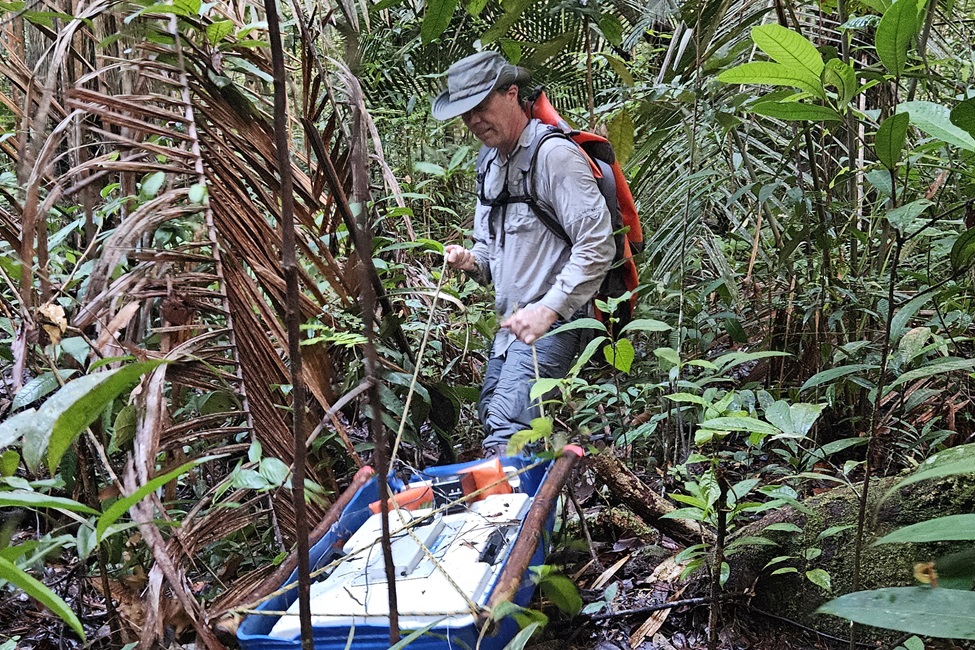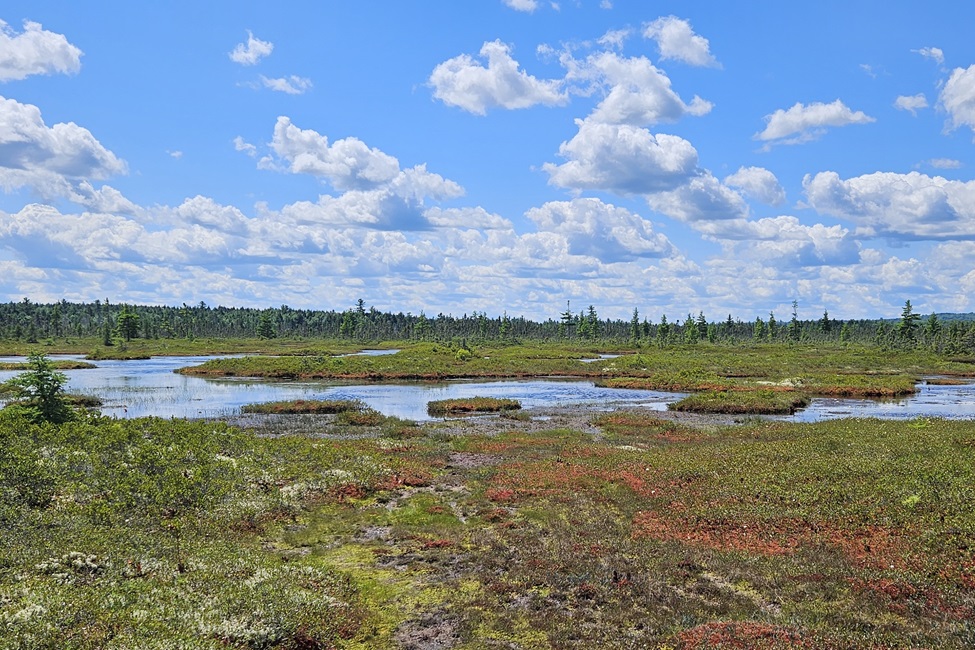Beneath the Bog: FAU Gets $1.3M to Track Carbon, Gas Flux in Peatlands

Xavier Comas, Ph.D., main principal investigator, performing a ground-based GPR survey in the Colombian Amazon near Inírida. (Photo credit: Angela Gallego-Sala, Ph.D., Exeter University)
Peatlands, a type of wetland found around the globe at all latitudes – from the Arctic to the tropics – are important ecosystems that store vast amounts of carbon. In fact, peatlands hold about one-third of the world’s soil carbon, despite covering only about 3% of the Earth’s land surface. When peatlands are disturbed or altered, they can release that carbon back into the atmosphere as greenhouse gases like methane. Peatlands are valuable ecosystems both for their biodiversity and for their role in regulating climate.
Researchers from Florida Atlantic University’s Charles E. Schmidt College of Science, in collaboration with Rutgers University and the University of Nevada, Reno, have received a $1.3 million grant from United States Department of Defense’s (DOD) Strategic Environmental Research and Development Program (SERDP), for a project focused on improving the accuracy of predicting carbon storage and gas emissions over a suite of peatlands covering a representative latitudinal gradient of relevance to the DoD, from Alaska to the Everglades. The goal is to reduce the uncertainty in these predictions by using an array of state-of-the-art geophysical methods that includes airborne ground-penetrating radar (GPR), and a new generation ground-based transient electromagnetic method (TEM).
A key part of the project titled, “Reducing Uncertainty in Carbon Pools and Free Phase Gas Fluxes in Peatland Ecosystems from Spatially Rich Geophysical Datasets,” is collecting rich, spatially detailed geophysical data to help more accurately estimate the amount of carbon stored in peatlands.
“Our project is designed to enhance our understanding of peat accumulation and gas distribution within the soil, particularly methane, by efficiently acquiring spatially rich datasets using novel geophysical approaches that includes deployment using drones,” said Xavier Comas, Ph.D., main principal investigator and a professor, FAU Department of Geosciences. “We will combine geophysical methods with direct soil and gas samples to explore the influence of factors such as soil physical properties, or gas composition and age, in regulating gas distribution and emissions. This understanding may help reduce uncertainty in overall gas flux estimates from peatlands in support of climate models.”
Additionally, the project will examine how specific environmental factors, such as the presence of permafrost or extreme weather events, affect the distribution and release of gases in these ecosystems. These peatlands will be selected across a range of latitudes, from Alaska to Florida, including sites in Maine and Minnesota.
“Our approach goes beyond traditional methods, such as drilling into the soil to collect core samples or estimating peat thickness based on surface elevation, and includes the use of drones,” said Comas. “Our methods will offer a better picture of how much carbon is stored and how gases are distributed, by improving on data collection efficiency that will allow for larger scale datasets and surveying in areas with challenging accessibility.”
Since drone-based GPR is still a relatively new technology, especially for carbon studies, this project also will help clarify how to best use this technology. The team will create clear guidelines that explain its limitations, challenges, and how to operate it effectively. This will make the technology more accessible to people who aren’t experts in the field, and it will contribute to the development of best practices within the Near-Surface Geophysics Inter-Society Committee, a group focused on advancing geophysical methods.
The research will take place at several field sites that are part of large federal research networks, including U.S. Forest Service experimental forests, the National Science Foundation’s long-term ecosystem research program (LTER), and the AmeriFlux monitoring network.
In addition to studying gas emissions, the research team will use their geophysical data to test a new model for understanding the development of raised bogs, which are a type of peatland. This model will help identify which areas of these bogs are most vulnerable to losing carbon (meaning the carbon can be easily drained away) versus areas that are safe from such loss, which will provide valuable information on how to better protect carbon stocks in these ecosystems.
“This project will significantly advance our understanding of ecosystem carbon management and provide a foundation for future research and action across the globe,” said Valery Forbes, Ph.D., dean, Charles E. Schmidt College of Science. “The development of practical guidelines for new technologies by Dr. Comas and collaborators empowers the scientific community to improve monitoring efforts worldwide. The results will have far reaching implications for climate policy, land use, and environmental conservation, particularly as we address the challenges posed from extreme weather events.”

An open pool area in a northern peatland near Grand Lake Stream in Maine. (Photo Credit: Xavier Comas, Ph.D., FAU)
-FAU-
Latest News Desk
- FAU Publishes Initial Annual Report: Florida Office of Ocean EconomyHoused at FAU, the Florida Office of Ocean Economy was created to position the state as a global leader in ocean-linked industries and to build the foundation for a thriving ocean economy.
- FAU Professor Highlighted for Park Designed for Coastal ResiliencyJeffrey E. Huber, professor in the School of Architecture within the Dorothy F. Schmidt College of Arts and Letters at Florida Atlantic, was recently featured in Architectural Record magazine for a park.
- FAU Foundation Raises $72M in 2025 Fiscal YearThe Florida Atlantic University Foundation (FAUF) raised more than $72.5 million from nearly 11,000 donors at the end of the 2025 fiscal year - the second largest amount raised in the university's history.
- FAU Report: Business, Job Growth Jumps in South FloridaSouth Florida's economy continues to outpace national growth, driven by strong employment gains and a surge in business creation, according to a new economic outlook report from Florida Atlantic University.
- FAU Earns 2025 Eduventures Innovation AwardFlorida Atlantic University is one of just four higher education institutions in the nation to be recognized with the 2025 Eduventures Innovation Award, presented annually by Eduventures Research.
- Study Refutes Blood Thinner Brain Bleed Risk After Falls in SeniorsFAU researchers found that warfarin use - even at high blood-thinning levels - did not significantly raise brain bleeding risk among 2,700 older adults admitted to the ER with fall-related head injuries.






